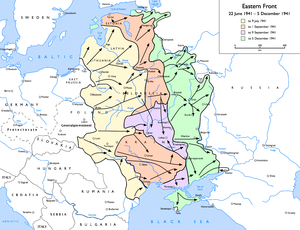
Back الإجلاء في الاتحاد السوفيتي Arabic פינוי אוכלוסייה בברית המועצות במהלך מלחמת העולם השנייה HE Evacuarea în Uniunea Sovietică Romanian Эвакуация в СССР во время Великой Отечественной войны Russian การอพยพในสหภาพโซเวียต Thai Евакуація в СРСР під час Другої світової війни Ukrainian

Evacuation in the Soviet Union was the mass migration of western Soviet citizens and its industries eastward as a result of Operation Barbarossa, the invasion of Russia launched by Nazi Germany in June 1941 as part of World War II. Nearly sixteen million Soviet civilians and over 1,500 large factories were moved to areas in the middle or eastern part of the country by the end of 1941.[1]
Along with the eastern exodus of civilians and industries, other unintended consequences of the German advance saw the execution of previously held western civilians by Soviet NKVD units,[2][3] the removal of Lenin's body from Moscow to Tyumen, and the relocation of the Hermitage Museum collection to Sverdlovsk. Kuybyshev was chosen as the alternative capital of the Soviet Union if Moscow fell to the invading Germans. During the summer of 1943, everything was moved back to Moscow. Soviet towns and cities inland or in the east received the bulk of the new refugees and high-priority war factories, with locations such as the Siberian city of Novosibirsk receiving more than 140,000 refugees and many factories due to its location away from the front lines.
Despite early German successes in seizing control of large swaths of western USSR territory throughout 1943 and sketchy contingency plans by the Soviets for mobilization in the east, Soviet industries eventually outpaced the Germans in arms production; a total of 73,000 tanks, 82,000 aircraft and nearly 324,000 artillery pieces were distributed to the Red Army in their fight against the Axis powers by 1945.[4]
- ^ Manley, Rebecca, and Rebecca Manley. To the Tashkent Station: Evacuation and Survival in the Soviet Union at War. Cornell University Press, 2009, pp. 7-8.
- ^ (in Polish) Encyklopedia PWN, Zbrodnie Sowickie W Polsce Archived 2006-05-21 at the Wayback Machine: After the outbreak of the German-Soviet war, in June 1941, thousands of prisoners have been murdered in mass executions in prisons (among others in Lviv and Berezwecz) and during the evacuation (so-called death marches)
- ^ Gottfried Schramm; Jan T. Gross; Manfred Zeidler; et al. (1997). Bernd Wegner (ed.). From Peace to War: Germany, Soviet Russia and the World, 1939-1941. Berghahn Books. pp. 47–79. ISBN 1-57181-882-0.[permanent dead link]
- ^ Freeze, Gregory L. Russia, A History. Oxford University Press, 1997, p. 330.
© MMXXIII Rich X Search. We shall prevail. All rights reserved. Rich X Search